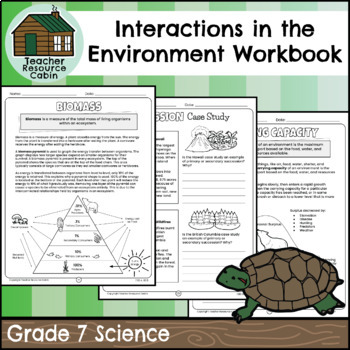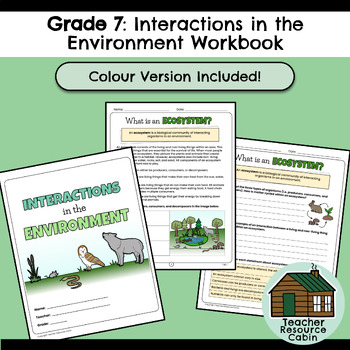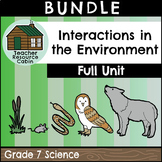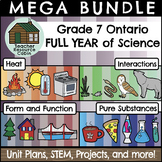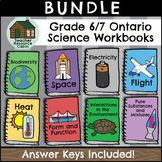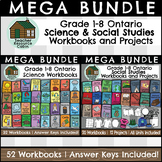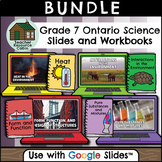Interactions in the Environment Workbook (Grade 7 Ontario Science)
- Zip
- Easel Activity
What educators are saying
Also included in
- This full unit contains everything you need for teaching the Grade 7 Interactions in the Environment unit in the NEW 2022 Ontario Science Curriculum! This unit includes a FULL unit plan (with suggestions for 21 daily lessons), a workbook, a slideshow, STEM experiments/investigations, a final projectPrice $33.98Original Price $37.75Save $3.77
- This full unit MEGA BUNDLE contains everything you need to teach Grade 7 Science, aligned with the NEW 2022 Ontario Science Curriculum! All four Grade 7 Science units are included: Interactions in the Environment, Pure Substances and Mixtures, Form, Function, and Design of Structures, and Heat in thPrice $130.00Original Price $153.00Save $23.00
- This BUNDLE includes FOUR independent workbooks for Grade 7 students aligned with the NEW 2022 Ontario Science curriculum. Each workbook meets the Ontario Curriculum expectations for an ENTIRE Science unit.All four Grade 7 Science strands are included: Interactions in the Environment, Pure SubstancePrice $35.00Original Price $39.00Save $4.00
- This BUNDLE includes EIGHT independent workbooks for Grade 6 and Grade 7 students. Each workbook meets the Ontario Curriculum expectations for an ENTIRE Science unit.In total, the workbooks include 367 pages of student worksheets! Interactive, hands-on activities are explained, with follow-up workshPrice $69.25Original Price $78.25Save $9.00
- This BUNDLE includes EIGHT independent workbooks for Grade 7 and Grade 8 students. Each workbook meets the Ontario Curriculum expectations for an ENTIRE Science unit.In total, the workbooks include 369 pages of student worksheets! Interactive, hands-on activities are explained, with follow-up workshPrice $69.00Original Price $78.00Save $9.00
- This MEGA BUNDLE contains workbooks for ALL Grade 1 - 8 Ontario Science Units. Each workbook meets the NEW 2022 Ontario Science Curriculum expectations for an ENTIRE Science unit. This product is PERFECT for a prep coverage teacher that teaches science to multiple grade levels. All workbooks are no-Price $292.00Original Price $313.25Save $21.25
- This MEGA BUNDLE contains workbooks for ALL Grade 1-8 Ontario Science and Social Studies Units. Each workbook meets the Ontario Curriculum expectations for an ENTIRE Science or Social Studies unit.This product is PERFECT for a prep coverage teacher that teaches science and social studies to multiplePrice $464.40Original Price $580.50Save $116.10
- This MEGA BUNDLE contains workbooks for ALL Grade 1-8 Ontario Science, Social Studies, and Health Units. Each workbook meets the Ontario Curriculum expectations for an ENTIRE Science, Social Studies, and Health unit.This product is PERFECT for a prep coverage teacher who teaches Science, Social StudPrice $688.80Original Price $861.00Save $172.20
- This BUNDLE includes complete student workbooks and slide decks for Grade 7 students, aligned with the new 2022 Grade 7 Ontario Science curriculum. Each workbook meets the Ontario Curriculum expectations for an ENTIRE Science unit. Slide decks are accessed using Google Slides™. All four Grade 7 SciPrice $72.50Original Price $81.50Save $9.00
Description
This workbook covers the Grade 7 Interactions in the Environment unit in the NEW 2022 Ontario Science curriculum (Life Systems).
Students will demonstrate an understanding of interactions between and among biotic and abiotic components in the environment. Topics covered include biodiversity, biotic and abiotic factors, primary and secondary succession, ecological pyramids, and protecting the environment.
Interactive, hands-on activities are explained, with follow-up worksheets included. There is a variety of readings, long and short answer questions, creative writing activities, and drawing prompts included to create a varied workbook suitable for many learning styles.
To support assessment practices, Ontario curriculum expectations (Strand A and B) are clearly identified on each page. A quiz is included at the end of the workbook.
Available in French: Les interactions dans l’environnement cahier (Grade 7 FRENCH Ontario Science)
⭐ Looking for teaching slides to accompany these workbooks? Interactions in the Environment for Google Slides™
This resource includes:
- 47-page Interactions in the Environment Workbook (B&W and Colour)
- 47-page Interactions in the Environment ANSWER KEY
- TpT Easel Activity - This tool allows students to complete workbook pages digitally, with no printing necessary. New to using Easel by TpT? Check out this guide.
Table of Contents
- Title Page
- Table of Contents
- K-W-L Chart
- What is an Ecosystem?
- What is an Ecosystem?
- What is Biodiversity?
- Biotic Factors
- Abiotic Factors
- Biotic vs. Abiotic
- Biotic vs. Abiotic
- Animal Classification
- Food Chains
- Food Chains
- Biomass
- Biomass Pyramids
- Food Web
- Food Web
- Matter Cycling
- Matter Cycling
- Matter Cycling
- Environmental impacts
- Ecological Balance
- Ecological Balance
- Succession
- Succession Case Study
- Carrying Capacity
- Carrying Capacity
- Carrying Capacity
- Endangered Species
- Endangered Species Case Study
- Invasive Species
- Invasive Species Case Study
- Invasive Species Assignment
- Invasive Species Assignment
- Invasive Species Assignment
- Protecting the Environment
- Protecting the Environment
- Protecting the Environment
- Protecting the Environment
- Protecting the Environment
- Protecting the Environment
- Vocabulary
- Vocabulary
- Interactions in the Environment Quiz
- Interactions in the Environment Quiz
- Interactions in the Environment Quiz
- Interactions in the Environment Quiz
Grade 7 Ontario Science Curriculum Expectations (2022)
B. Life Systems - Interactions in the Environment
B1. assess the impact of human activities and technologies on the environment, and analyse ways to mitigate negative impacts and contribute to environmental sustainability
B2. demonstrate an understanding of interactions between and among biotic and abiotic components in the environment
Please read our Terms of Use prior to using this resource.
©Copyright Teacher Resource Cabin
Buyer Tip:
If you have purchased this product, please leave feedback! We are always looking for ways to improve our store and your input is important. You will earn TpT Credits by leaving ratings and reviews on your purchases. For every $1 you spend on TpT, you can earn 1 credit. Every 20 credits earned equals $1 you can apply to future TpT purchases.

